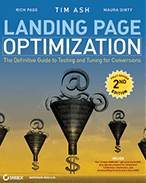Make Your Website Visitors Happier with Behavioral Targeting: A Beginners Guide
Last updated | Behavioral targeting – it sounds like something you would learn (and quickly forget) in college, right? But did you know that by using behavioral targeting on your website you can actually make your website visitors happier? And we all know what happier website visitors mean – more repeat visits, more conversions (sales, signups etc), and more people spreading the word about your site. Sounds great right?
Behavioral targeting – it sounds like something you would learn (and quickly forget) in college, right? But did you know that by using behavioral targeting on your website you can actually make your website visitors happier? And we all know what happier website visitors mean – more repeat visits, more conversions (sales, signups etc), and more people spreading the word about your site. Sounds great right?
So I thought I would write a beginners guide all about behavioral targeting, and hopefully help you understand the importance of it. So, lets get started…
Whats so good about behavioral targeting? Well. Imagine walking into a bar where everyone knows your name, and your favorite drink is sitting at the bar waiting for you, without you having to ask for it. Not bad eh? Now imagine going to a website that welcomes you with your name, and shows you content relevant to what you looked at the last few times you were there. This happens more often than people think – especially on ecommerce sites like Amazon.com and eBay. Go back and visit some of your favorite sites – how do they know what you are looking for? Well, they use behavioral targeting.
So how does it work? When you visit a website, you are ‘cookied’ – a cookie gets stored on your computer with your visit details. Websites that use behavioral targeting then use this cookie to put you in a specific segment based on your behavior or how you arrived (like first time user, frequent visitor to music section, visitor from a newsletter etc). Depending on what segment you are in, you will get relevant content shown to you – often different than other users will see. And this content will hopefully be more related to what you really want to see, thus improving your website experience. And its been proven to work VERY well – many large websites are already using this with great results.
What are some good ways to use behavioral targeting? Well, there are many different ways to segment and target your users. Here is a list of some of the better ways to meet your visitors needs better and make them happier:
- Show welcome content to new visitors, and ‘welcome back’ content to repeat visitors (ideally, show their name/username). I actually do this on my blog – see at the top of each post.
- Show content to visitors relating to their previous purchases (much like Amazon and other leading ecommerce websites do).
- Show content to visitors relating to previous content seen. Like if a user on an electronics site looked at cameras the last two times, show them cameras on the homepage when they return.
Enough of the basics. What about about some more advanced ideas? Sure, here are some methods that will help you stand out from the crowd:
- Show different coupons relating to items visitors have purchased before or put in their shopping cart. This will increase conversions and hopefully increase sales.
- Show the user ads relating to what content they have previously seen. Not only does this make the ads seem less annoying for visitors, but it also increases click through rates on ads, which is great for sites trying to make money that way (like media sites).
- Depending on what search keywords a user arrives to the site, dynamically insert them into content. This way it will match users needs better and reduce the chances of them leaving early.
What’s the best way to start behavioral targeting on my site? A new great tool you can start experimenting with is called BTbuckets, and it allows you to being doing some basic behavioral targeting, by segmenting users and then showing them relevant content. If you want to get more advanced, you can use more robust solutions offered by Magnify360.com or SiteSpect.com. Also, for more indepth posts on this topic, check out Anil Batra’s great blog which covers behavioral targeting very well, and has great tips and advice.
What else is important for behavioral targeting? Well, if you go into behavioral targeting blind with no idea of what you want to achieve, then it probably won’t work well for you. Remember to first set your goals and what would determine a successful behavioral targeting implementation.
So there we have it – hopefully I have enlightened you and you now understand a little bit more about behavioral targeting. Go ahead, start experimenting… your visitors visitors will be thanking you!



